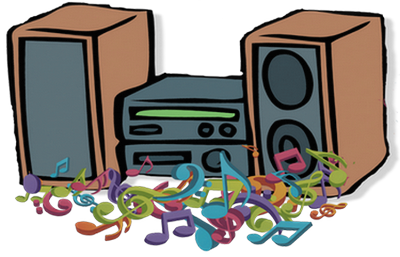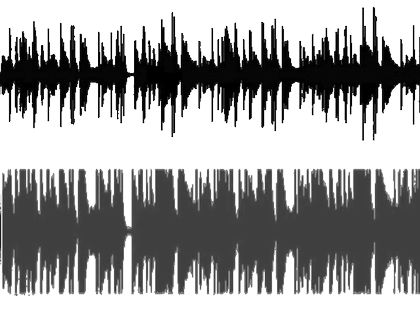 Contact
Home
Chapters
Contact
Home
Chapters
A Musical Dark Age

Music has been with us throughout history. Starting from chants and drumming around the communal fire then to the proliferation of acoustic instruments in the middle ages and on to the composition of complex symphonies and even to popular music of today, it has always been with us. We connect with it. It influences us. It plays with our emotions. In its own way it speaks to us.
So, if this is such a powerful force in our lives, how is it that so many people's music collections end someplace in the 1990s, 25 years ago?
I will confess that most of my listening is from the later 1960s through the early 90s. My friends sometimes chide me about it. They tell me I'm stuck in the past and that I need to branch out and enjoy today's music too.
But, the truth is that when I listen to today's popular music, I don't get it. I can't connect with it. In fact, it doesn't really sound like music to me at all. It lacks the range and feeling, the humanity, of older music. It strikes me as aggressive and over produced. It comes off as mechanical and stilted. It drills itself into my ears and usually the session ends with a headache.
To be fair, there is good new music out there but it's not playing on the charts or being promoted on streaming sources. One has to be somewhat ambitious and go looking for it.
So, yes, there is a reason why my music collection ends where the new millennium began.
The death of originality Home Top Chapters
For most of history music has been an artistic undertaking, strongly favouring entertainment value. People used to gather in theatres and auditoriums to listen to live performances. It was a night out, an event of significance and often a rather formal affair.That all changed with the advent of recording. Suddenly, music was available in our homes and a profit motive was born from the selling of recordings. This, in itself, was not a bad thing. The dominant focus on artistry, composition and originality held right up to the early 1990s. Music was diverse, rich and well made to attract an audience that would appreciate it on merit and hopefully buy both concert tickets and albums of the artist's music.
As society in general moved from a customer service focus to one that favoured investors, the profit motive became dominant and music was also slowly transformed from its artistic roots into a marketing commodity. Competition grew between artists and between record labels. Music was re-imagined to support greed. Suddenly, artistry took a back seat to accounting and profit was more important than entertainment.
The impact from this on today's music is as sweeping as it is damaging. It has become homogenized into sound alike songs written not for artistic merit but for marketability. The recordings are orders louder than they used to be as each new song tries to grab our attention by being the loudest on the list. The fullness and complexity of the music has suffered. Lyrics have been largely reduced to tribal chants. All this in the name of selling more copies.
The loudness wars Home Top Chapters
In music Dynamic Range is defined as the ratio between the loudest and softest parts of a song. Artistically composed music naturally has a fairly large dynamic range as part of it's expression. This can range from the quiet tinkle of a small bell to the roaring crescendo of a full orchestra. Or from the simple intro to a rock song to it's sudden burst into full performance.In recording, Dynamic Range also refers to the amount of space between the background Noise Floor of the medium (tape, vinyl, etc.) and it's maximum loudness. In the early years this limitation of the medium posed a problem for audio engineers. Magnetic tape and vinyl records did not have the space to accommodate the full dynamic range of most music so a device called a Compressor was used to boost up the quietest parts to get them above the background noise. The maximum level was then set to be just below the level at which the loudest parts were clipped off. For nearly 40 years this produced very high quality recordings with low distortion and a rich fullness of sound.
Then came the shift to digital recording and compact disks. Now, for the first time, the medium had all the range needed to accommodate the full expression of music. This came as both a lower noise floor and greatly enhanced maximum levels. This should have been the answer to the recording engineer's dreams. But it also posed the need to change the way they did things and many did not adapt well to the new methods.
As soon as marketing agents realized the new formats allowed for much louder recordings, they knew it was possible to make their music stand out in the playlists of radio stations and dance parties. The Loudness War was launched. Everyone was trying to be the loudest song on the air.
To further increase loudness, a newer technique called "Limiting" also came into use to further compress music by lopping the tops off the loudest parts, making it sound even more aggressive and less like music.
As this loudness war progressed, the demand for a more market driven sound increased. Engineers began compressing music more and more. Dynamic range all but vanished from modern music. Most music was "Brick Walled" and everything was as loud as they could make it.

Home audio enthusiasts will be well aware of this because switching from a turntable to a CD player most often resulted in a mad dive for the volume control.
Then, just to make it worse, record labels started re-releasing their vinyl records on CDs but with the sound re-mastered. It is hard to believe the two oscillographs at the right are from the same song but they are. The top one is from a vinyl album and the bottom one is from a CD of the same music.
Of course this also increased the levels of distortion in modern music. Where tape and vinyl recordings often had less than 1% distortion, now we were getting music recorded with 25% or more. Needless to say, this was something of a disaster for those with a good ear for quality and probably inspired more than a few headaches along the way.
The result was quite literally "the day the music died" and it is all nicely catalogued online at the Dynamic Range Database. Sadly one has to go back quite a few years to find even minimal dynamics in music.
It is deeply ironic that a distribution medium that finally accommodates the full dynamic range of music was being used to offer the least.
Crushing music's soul Home Top Chapters
On top of the loudness wars, a number of techniques are being used on recorded music that really aren't helping.Quantization, the business of aligning all sounds to a precise time marker is contributing to a new mechanical sound in music. Real musicians are not that precise. Sometimes the tempo strays a bit. Sometimes a musician is a bit late or early with a note or drum strike. These minor errors add humanity and variety to music, removing them does the opposite.
AutoTune aligns each word or note to the perfect pitch for a musical note. Once again, neither musicians nor singers are that precise. Sometimes a note is missed, sometimes one sings slightly off key for a moment. This software fixes it so that every note is perfect. In fact, when AutoTune is used at it's limits you don't even have to sing to make an album.
Chorusing is a technique that makes one voice into many. Basically it takes a single sound and adds copies of itself but very slightly delayed. The result is that a single note will sound like a complete row of musicians playing together. While this isn't destructive, per se, it is dishonest and can be used to transform a weak performance into something artificially grand.
Reverb adds echo effects to music. This can be used gently to make a small room sound larger or to enhance the sustain and depth of a note. Taken to extremes it comes off as a delayed echo, like shouting into a pipe.
Overuse of these effects to fix a bad performance has created a whole new problem. There are now many cases where a performer's new album can't be performed live without significant loss of apparent talent. So, rather than making the album sound like a live performance, the challenge is to make the live performance sound like the recordings. As a result, many concerts are now using the recorded tracks and are little more than dancing and spectacle performed for the audience to see.
Regaining our senses Home Top Chapters
Fortunately there is a light at the end of this tunnel. The way music is delivered to the listener is changing and streaming audio sources are leading the way.In traditional analog recordings there was a standard called Line Level. Basically this was an agreed upon standard level for the signals in a recording console of 1.225 volts and 0.5 volts for home playback equipment. Most home entertainment equipment was and still is designed around this standard.

When the loudness wars started the standards went right out the window. As levels were pushed higher and higher, it was not uncommon for CDs and digital files to produce levels of 3 or 4 volts as normal. This, of course, leads to that mad dive for the volume control.
But since the new digital dynamic range is bigger than the old analog one, it should be obvious that if we overlay one on the other, there must be some point at which the digital output corresponds with the standard analog one. This is called the Alignment Level which corresponds to at about -18db of full scale in the digital space. That is to say, in order to get the same playback levels it is necessary to record at well below the maximum levels possible in digital recordings.
This is a good thing. It gives back the open space both above and below the target level needed to properly reproduce the full dynamics of most music. By reducing compression and limiting, using this space, we restore music's dynamic range and we get a much more natural sounding reproduction.
Standards are finally emerging and streaming audio providers are already following them. They have developed a standard for loudness normalization based on perception, allowing them to level the volume of each song as it is streamed. No more extra loud songs or panicked volume adjustments. The super loud stuff is now being turned down to the point where it's often not as loud as properly produced recordings.
As streaming gains in popularity this normalization of perceived loudness will effectively end the loudness war and hopefully it will foster a new push toward talented musicians, human sounding performances and high quality recordings that will find it's way into digital files, CDs and even old school vinyl recordings.
Summing up Home Top Chapters
The last 20 or so years have been a musical dark age. It has produced a lot of stuff that anyone who truly appreciates good music would deem unlistenable. But there is hope with streaming services leading the way back to musical sanity.With a bit of luck, my anachronistic musical tastes will soon get the update I keep hoping for.